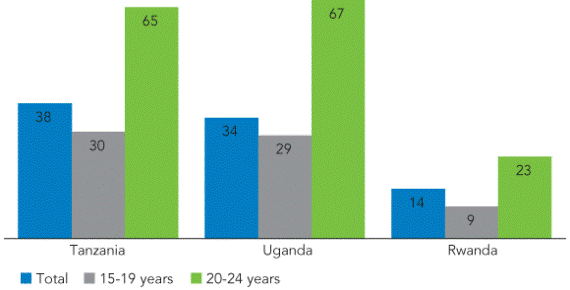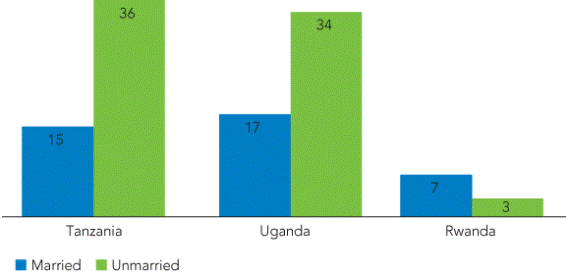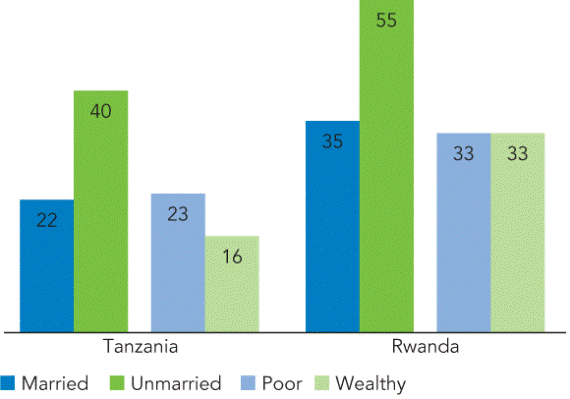
Reproductive Health of Youth in East Africa
(April 2010) Youth in parts of East Africa have among the world’s highest rates of HIV infection, in part because of their limited knowledge of sexual and reproductive health. In addition to the high risk of HIV/AIDS, young women in the region are vulnerable to unintended pregnancies that can negatively affect their health, educational opportunities, and life goals.
Knowledge of family planning methods and use of contraceptives are important indicators of sexual health among youth. Their sexual behavior and contraceptive use not only vary across countries and regions, but within a country as well. This article examines data from the Demographic and Health Surveys (DHS) conducted in three East African countries—Tanzania, Uganda, and Rwanda—and explores the variation in sexual knowledge and practice among youth ages 15 to 24 in these countries. This information can help policymakers and program managers develop programs that more effectively respond to the sexual and reproductive health needs of youth.
Sexual Behavior
Levels of sexual activity among young unmarried women are similar in Tanzania and Uganda, but the experience reported by young Rwandan women was very different (see Figure 1). In Tanzania and Uganda, approximately 35 percent to 40 percent of young unmarried women reported that they had been sexually active. In contrast, only 14 percent of unmarried young women in Rwanda indicated that they had ever had sex—among the lowest levels in sub-Saharan Africa.
Figure 1
Percentage of Young Women Who Have Had Sex by Age

Source: Shane Khan and Vinod Mishra, “Youth Reproductive and Sexual Health,” DHS Comparative Reports No. 19 (Calverton, MD: ICF Macro, 2008).
The median age at first sexual intercourse for women ages 20 to 24 in both Tanzania and Uganda is 17.1 years; in Rwanda, the median age above age 20. (The median is not calculated for this age group in Rwanda in survey reports because fewer than half of women ages 20 to 24 included in the survey had initiated sexual activity by age 20.) As expected, sexual experience increases with age. In Tanzania and Uganda, women ages 20 to 24 were more likely to have had sex (65 percent and 67 percent, respectively); but in Rwanda, levels of sexual activity even among those ages 20 to 24 was much lower at 23 percent.
In different countries, such factors as education, place of residence, exposure to media, and wealth are often associated with the level of sexual activity. In Uganda, the percentage of women who reported sexual activity increased with higher levels of education, urban residence, more exposure to media, and greater family wealth. In Rwanda, the patterns were similar—sexual activity increased with urban residence, higher levels of education, more exposure to media, and in wealthier households—but the levels of sexual activity were much lower than in either Uganda or Tanzania. In Tanzania, according to the DHS, there was very little difference in levels of sexual activity based on education or exposure to media; however, young women in urban areas and those from wealthier households were more likely to have initiated sexual activity than those in rural areas and from poorer households. For example, regardless of education level, 37 percent to 39 percent of unmarried Tanzanian women between ages 15 and 24 reported that they had ever been sexually active. In contrast, young unmarried women with higher education levels in Uganda were much more likely ever to have had sex as young unmarried women who never attended school (46 percent compared with 28 percent). Also, among young Ugandan women, almost twice as many from the wealthiest group reported ever having sex as those from the poorest group (50 percent compared with 27 percent).
Contraceptive Use Among Youth
Among sexually active youth, contraceptive use reduces unplanned pregnancies. However, before using a contraceptive, youth must know about specific methods. In Tanzania, more than 90 percent of young women surveyed knew at least one type of modern contraception, and 82 percent knew three or more modern methods. Knowledge of one method among young women in Rwanda was also high (91 percent), but only 67 percent had knowledge of three or more methods.
Given the relatively high levels of knowledge of contraceptives among young women, use of contraceptives is relatively low among married women, but generally higher among sexually active unmarried women. In Uganda, 17 percent of married young women use modern contraception; in contrast, 34 percent of unmarried sexually active young women use modern contraception (see Figure 2). Prevalence was slightly higher in Tanzania at 15 percent of young married women and 36 percent of unmarried sexually active young women. The use of modern contraception was much lower in Rwanda, where 7 percent of married young women use modern contraception and 3 percent of unmarried, sexually active young women. In all three countries, the number of unmarried sexually active young women was relatively small, so they represent a small percentage of young women, although their contraceptive use may be higher.
Figure 2
Percent of Women Ages 15-24 Using Modern Contraceptives

Source: Shane Khan and Vinod Mishra, “Youth Reproductive and Sexual Health,” DHS Comparative Reports No. 19 (Calverton, MD: ICF Macro, 2008).
Living in an urban area is associated with contraceptive use for young married women in all three countries. The largest difference was noted in Uganda, where 39 percent of young married women in urban areas used contraceptives compared with only 14 percent in rural areas. A higher level of education was also associated with higher use of modern contraceptives among young married women. In all three countries, young married women who had a secondary education were much more likely—as much as four times more likely in Rwanda—to use modern contraception than women with only a primary education. Similarly, married young women in the highest wealth quintile reported higher levels of modern contraceptive use (18 percent to 34 percent), compared with the poorest group, where prevalence ranged from 5 percent to 13 percent.
Unmet Need for Family Planning Among Young Adults
In addition to the relatively low levels of modern contraceptive use among young women, a large percentage of young married and unmarried women do not want to become pregnant within the next two years, but are not using an effective contraceptive to avoid pregnancy. These young women have an unmet need for family planning and, without access to modern contraception, they face the risk of an unintended pregnancy. In Tanzania, 22 percent of young married women ages 15 to 24 indicate that they have an unmet need, as do 40 percent of sexually active, unmarried women in this age group. The unmet need is even higher in Rwanda—35 percent of young married women report an unmet need, as do 55 percent of sexually active, unmarried young women in that country (see Figure 3). (Data are not available on young women in Uganda.)
Figure 3
Unmet Need for Family Planning Among Women Ages 15-24

Source: Shane Khan and Vinod Mishra, “Youth Reproductive and Sexual Health,” DHS Comparative Reports No. 19 (Calverton, MD: ICF Macro, 2008).
As noted above, such factors as household wealth and place of residence often affect access to and use of modern contraception. In Tanzania, household wealth is related to unmet need: 23 percent of young poor women report having an unmet need, while 16 percent of young wealthy women do. In contrast, household wealth has little effect in Rwanda; 33 percent of both poor and wealthy young women indicate that they have an unmet need for family planning.
Understanding the sexual behavior and contraceptive use of East African youth can help improve policies that address reproductive health knowledge and behavior among young women in the region. Young women are empowered by increased knowledge in these areas; they can have more control of their reproductive health and access family planning resources where their needs are not being met. Improvements in sexual health behavior and knowledge among youth can help slow the spread of STIs including HIV infection, as well as reduce unplanned pregnancies—allowing for a healthier generation of families.
James Gribble is vice president of International Programs at the Population Reference Bureau.
Reference
Shane Khan and Vinod Mishra, “Youth Reproductive and Sexual Health,” DHS Comparative Reports No. 19 (Calverton, MD: ICF Macro, 2008).
